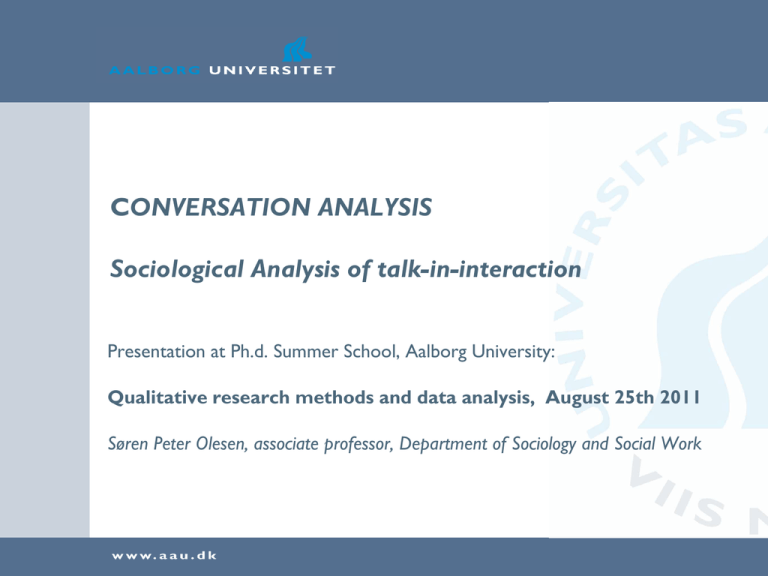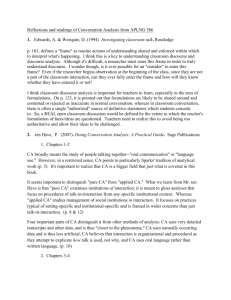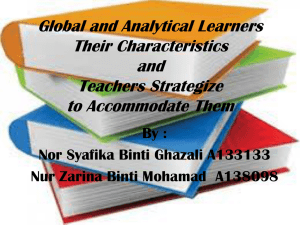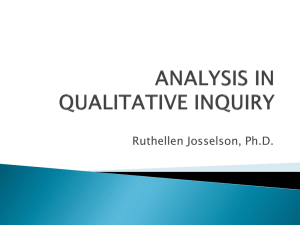Document
advertisement

CONVERSATION ANALYSIS Sociological Analysis of talk-in-interaction Presentation at Ph.d. Summer School, Aalborg University: Qualitative research methods and data analysis, August 25th 2011 Søren Peter Olesen, associate professor, Department of Sociology and Social Work Overview • • • • • • • An example: Harassment in action Introduction The theoretical tradition from which CA as research methodology derives. The analytical specifics of CA The type of research questions, CA can answer What makes CA unique compared to other discourse and narrative analytic methodologies? Concluding remarks Harassment in action MP: Girl: MP: Girl: MP: MP: MP: Girl: MP: Girl: … When shall we go for a ride then. (.) What did you say. When shall we go for a ride. (.) Hey listen I don’t k_now_hhh (.) h What? (0.6) Are you coming with me then. (0.5) Do you dare to come. <I don’t know. Hhh But come along, (0.6) Why is that Harassment in action … underpinning her (Tainio 2003) analysis is an attempt to show how actions which can be heard as a form of harassment (and, indeed, which did come to be heard that way by the jury, journalists and the public at large) are predicated on, mobilised in and resisted through mundane practices of interactional organisation. And in this Tainio makes a significant contribution, because she shows that it is possible to develop a conversation analytic account of the infrastructure of sexual harassment. (Wooffitt 2005) Introduction CA is about ‘what comes after what’ in talk-in-interaction (Antaki 1994:69) According to CA participants orient to interaction (Heritage 1997:162): • Addressing themselves to the immediately preceding talk; talk is contextshaped • Projecting some next action; talk is context-shaping • Showing an understanding of what is going on; talk represents sequential intersubjectivity categorisation and narrative CA is dedicated empirical/’objectivistic’ and qualitative Two tracks in CA (ten Have 1999:8: at least two kinds of conversation analytical research going on today): • The institutions of social interaction • The social institutions in talk-in-interaction. ‘Applied’ CA The ’birth’ of CA Data: Taperecordings of telephone calls to a help-line at a psychiatric hospital (Sacks 1992a+b) (1)A: Hello B: Hello (2) A: This is Mr Smith may I help you B: Yes, this is Mr Brown (3)A: This is Mr Smith may I help you B: I can’t hear you A: This is Mr Smith B: Smith The ’birth’ of CA Data: Talk in therapeutic settings. Turn-taking – example of a ’list’ and of collectively produced talk: Therap: Bob: Th: Bob: Joe: Th: Henry: Bob: Th: Joe: Henry: Mel: Bob this is uh Mel Hi Joe Hi Hi Henry Hi Hi Bob Reed We were in an automobile discussion discussing the psychological motives for drag racing on the streets (Lectures on Conversation 1:136) The ’birth’ of CA Data: Talk in social work setting. Turn-taking; categorisation and category bound activities; narrative; ’objects’ and ’machinery producing that kind of objects’ A: Yeah, then what happened? B: Okay, in the meantime she <the wife of B> says: “Don’t ask the child nothing.” Well, she stepped between me and the child, and I got to walk out the door. When she stepped between me and the child, I went to move her out of the way. And then about that time her sister had called the police. I don’t know how she … what she … A: Didn’t you smack her one? B: No. A: You’re not telling me the story, Mr. B. B: Well, you see when you say smack you mean hit. A: You shoved her. Is that it? B: Yeah, I shoved her (Lectures on Conversation 1:113) Theoretical tradition • • • • • • A functional conception of language (Wittgenstein 1953): Language as performative and functional; language as constructive and constitutive of social life (Rapley 2007); using language producing a world of communicative practice Inductive, qualitative and ‘objectivistic’ (Sacks 1992) Ethnomethodology (Garfinkel 1967; 2002) Focus on member’s rather than researchers’ knowledge and methods Interaction ritual / interaction order (Goffman 1967; 1983) reproducing vs. softening and loosening structural traits ‘Objects’ and ‘devices’; the machinery producing them; a ‘social microphysics’; sequentiality and categorisation; ‘inference-making machine’ (Sacks 1992) ‘What comes after what’, not letting an a priori theoretical framework ‘colonise’ description and analysis How members ‘assemble the social’ (Schegloff 1999) Theoretical relevance Focus on ‘What comes after what’ (Antaki) How members ‘assemble the social’ (Latour 2005) and categorisation, positioning and rhetoric – rather than on causal explanations and sociological theory about actors and their motives, dispositions and positions Focus on the situational and the situated (Goffman 1983) Situation, disposition, position (Mouzelis 1995) Social constructionism (Burr 1995) questioning everything we might take for granted, however not departing from a specific critical theory and an emancipatory project Critical realism (Archer 1995): Generative mechanisms (Pawson & Tilley 1997) producing the social; structure vs. agency; devices vs. interaction and relations Analytical specifics - 1 The analytical specifics of CA: Ways of making available and of making up existing materials (rather than researcher-generated) for analytical purposes (Flick quoted in Rapley 2007) Analytical specifics - 2 Institutions of social interaction: Seeking ‘universal’ or general rules about talk-in-ineraction, e.g.: • • • • • • • Turn-taking, sequentiality and turn-design Pairs Preference Repair Openings Closings … Analytical specifics - 3 Social institutions in interaction / Institutional talk: Applying CA on particular cases of talk-in-interaction; institutional interaction, e.g. education and pedagogy, health and social care, social welfare and employment Institutional interaction is normally characterised by (Heritage 1997:163f): • Specific goal orientations • Special constraints on what is considered allowable contributions • Particular inferential frameworks and procedures Research questions The type of research questions, CA can answer: • • • Why that now? – in the sense that members look at things How rather than why? How is this done in this case, in this situation, this time CA and other discourse analytical methodologies Various selected approaches to the analysis of institutional interaction: • Institutional ethnography • Ethnomethodology and Conversation Analysis • Sociolinguistics and pragmatics • Critical Discourse Analysis (Sarangi & Roberts 1999) CA and other discourse analytical methodologies CA (and partly DA) focuses on language use, everyday interaction whether mundane or institutional, authentic data triviality? Recordings (sound or video) of verbal communication. CA’s empirical strengths!? (Wooffit 2005:88) CA and other discourse analytical methodologies CDA vs. CA: The question of interconnections between linguistics patterns and the broader social contexts (social, political and economis structures (e.g. Layder 1993; Linell 1998). DP / DA vs. FDA / CDA: ’Thin’ linguistic analysis vs. ’thick’ (!?) sociological analysis – language embedded in social institutions and technologies. CA and narrative analysis The development in narrative analysis Grand narratives About a nation or ethnic group, about the role of a social class, a political organisation or a specific way of organising society etc. Big (biographical) narratives About the life history of an individual Small narratives Ad hoc positioning in everyday settings, moves taken in concrete present situations vis-à-vis others, often unnoticed as narratives From grand/big to smal narratives and from structure to interaction CA and narrative analysis “‘Big Stories’, i.e., life stories or autobiographies, or at least stories of life determining (or threatening) episodes have come to take the center stage in narrative studies in the human sciences. ‘Big Stories’ are typically stories that are elicited in interview situations, either for the purpose to create research data or to do therapy – stories in which speakers are asked to retrospect on particular life-determining episodes or on their lives as a whole, and tie together events into episodes and episodes into a life story, so that something like ‘a life’ can come “to existence”. Situations, I will argue, in which ‘Big Stories’ are constructed, are particular kinds of occasions in which speakers have been provided with a particular opportunity for reflection; occasions in which they have been lured or seduced into a particular type of accounting practice (also often called ‘disclosure’); occasions to which the participants have agreed, but occasions that are also quite different from situations in which “small stories” emerge.“ (Bamberg 2006, s. 2-3) CA and narrative analysis “…the term “small stories” is meant to refer to stories told in interaction; stories that do not necessarily thematize the speaker, definitely not a whole life, but possibly not even events that the speaker has lived through – and now, retrospectively, reflects upon and recounts (often termed “personal stories” or “narratives of personal experience”). Rather, “small stories” are more the kinds of stories we tell in everyday settings (not just research or therapeutic interviews). And these stories are most often about very mundane things and everyday occurrences, often even not particularly interesting or tellable; stories that seem to pop up, not necessarily even recognized as stories, and quickly forgotten; nothing permanent or of particular importance – so it seems.” (Bamberg 2006, s. 1-2) Uniqueness In sum: What makes CA unique compared to other discourse analytic methodologies? Talk-in-interaction Turn-taking and sequentiality Categorisation and narrative in interaction Existing materials Specific analytic procedures Transcriptions of data Authentic data from concrete situations Sound or video-recordings The words as spoken Sounds that are uttered Inaudible or un-understandable sounds and sections Pauses / silences Overlapping talk and sounds Tempo, intonation, strength Format of transcription Addition of visible information Translation Selection, ’cases of what?’ (Ten Have 1999; Nielsen & Nielsen 2005) Concluding remarks 1 Concluding remarks: • • • • • • Critique and discussion The Sacks-heritage (Silverman 1998) The short-sightedness of CA!? (Wetherell 1998; Schegloff 1998; Billig 1999; Schegloff 1999; Scheuer 2005; Kjærbeck 2008) Immediate vs. mediate contexts (Schegloff 1997; Linell 1998; Erickson 2004) CA and other discourse analytical methodologies (Wooffitt 2005; Rapley 2007) CA and narrative analysis Concluding remarks 2 Concluding remarks: CA and e.g. social work research; a profound relevance associated with social work and counselling as authentic communicative practice / language use / language games; a conflation of activity types and discourse types (Sarangi 2000) Reservations: • • • What is actually turns and how do you observe turns; is there a ’nano-physics’and a ’meso-physics’ of interaction? At a mezo- and macro-level: the occurrence and character of turns not lying immediately close to each other as well as the occurrence and character of monological traits The characterisation of everyday life as primordial and immortal and as realised in comunicative practice including assumptions dialogue, equality, reciprocity and balance is problematic; interaction is allways embedded and social institutions maybe allways present Discussion • Is it important to study language use, or are the most important things happening, so to speak, behind the back of the participants in social work practice?








